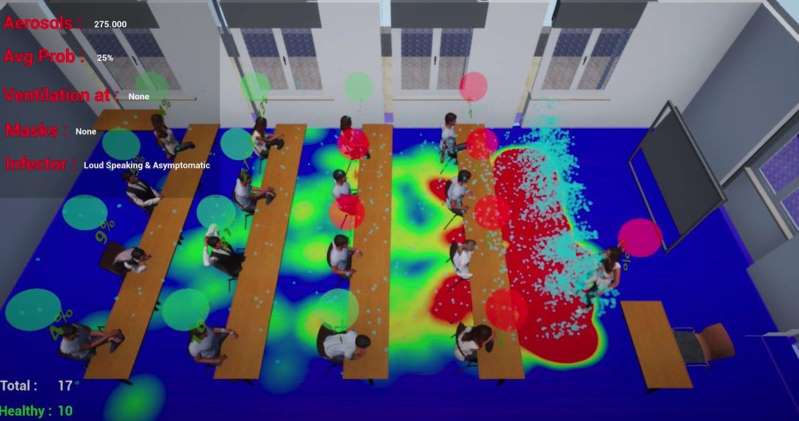A new Covid-19 simulator makes the aerosol dispersion in offices, classrooms and gondolas visible and calculates where the risk of infection is high.
Already towards the end of the first lockdown, Gerald Dipplinger and his team asked themselves the question: “If we are allowed back into the office – an open-plan office in the Vienna DC Tower – how is it determined how many people are allowed in? 30, 50 or 70 percent of the workforce? The answer – 30 percent – came more from the gut and was not very satisfying from a scientific point of view for the Artificial Intelligence team of the consulting firm PwC. Project manager Dipplinger’s ambition was aroused – he wanted hard data.
“So we built a digital twin for our floor and started simulating it: How many contacts are made when you send 30 percent of the staff in, or 50 or 70 percent. The first thing we learned from the computer simulations was that it’s not so much the number that matters, but how much people move around.”
Six months later, the Artificial Intelligence Team, together with the project partners Samariterbund and AIT Center for Technology Experience, has now presented the Covid-19 simulator, a computer-based aerosol and movement tool made in Austria.
The researchers calculated a particularly high risk of infection for rooms where people speak loudly and are poorly ventilated. However, the risk depends on the specific situation:
- In open areas you can also get infected by a loudspeaker at a distance of more than two meters.
- If such open spaces are poorly ventilated and there is a lot of loud talking (e.g. in a call center), asymptomatic persons are very likely to infect others – even if they are sitting seven meters away from the infected person.
- In this case, partition walls also proved to be hardly effective. Even masks do not have a significant effect on the occurrence of infection in well-ventilated rooms and when working quietly in certain constellations.
- Asking the people present to lower their voices or to speak loudly only in a separate, ventilated room could reduce the probability of infecting at least one other person to below one percent.
Interesting for others
When Dipplinger was through with his open-plan office, he thought: “The simulations could also be interesting for other companies,” he says in an interview with the KURIER and brings the Samaritan League on board. “We then took a look at the teaching operation using the Samariterbund’s classroom as an example. But call centers, open-plan and small offices were also simulated,” says Andreas Balog. The good news: “The Covid-19 simulator confirmed the usual protective measures – mask, ventilation, spacing”. Balog, management at Samariterbund Österreich, continues: “All findings are incorporated into our Covid prevention concepts”.
In any case, the researchers see considerable potential for application: whether offices, schools or universities, leisure facilities such as dance schools, stadiums or ski resorts – they could all have the risk of infection checked in their operations. “Whereby a ski lift operator would probably have the critical situations digitally reproduced – the gondola, the queuing, the hut visit,” Dipplinger thinks loud. “In general, it seems to make the most sense to simulate critical points – the access to buildings or the lunch breaks.” As long as there is still no comprehensive vaccine available, he says, one must continue to rely on sensible and individually tailored protective measures. “This is the only way we can maintain operations in times of pandemic and at the same time prevent a further lockdown,” he said.

Speaking of the considerable application potential: “By the way, the simulator can be easily applied to any other pathogen – to influenza as well as the norovirus,” says Dipplinger. After all, this pandemic will also end at some point.
hp, Source: kurier.at. pictures: Pwc Austria
This post has already been read 1385 times!



